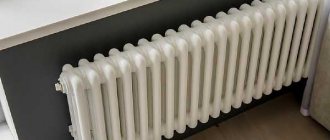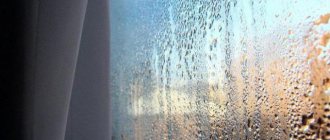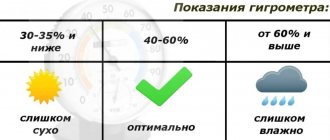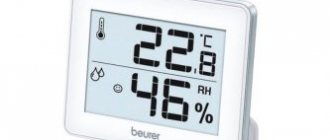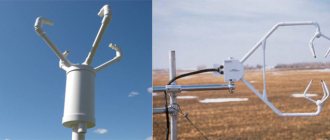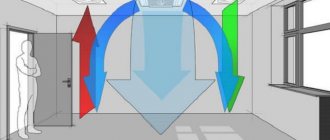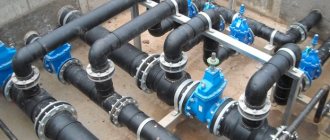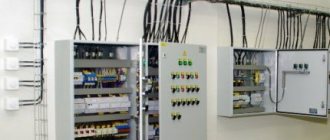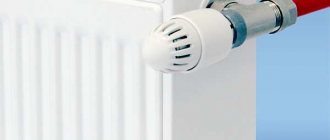Application of psychrometric measurement method in industry
There are many different methods for measuring relative humidity. And along with such modern methods as condensation (“dew point mirror”) or capacitance, the psychrometric measurement method still remains relevant due to its simplicity and accessibility. Often, psychrometers can be seen on the walls of apartments or offices (see Figure 1).
Figure 1 — Appearance of the August psychrometer
Anyone can, based on the readings of two thermometers and the psychrometric table depicted on its body, determine the relative humidity of the surrounding air with an accuracy acceptable for a household humidity meter. But what are the features of this measurement method and how applicable is it as an industrial hygrometer?
Popular types of devices
The procedure and features of measuring humidity levels with a hygrometer depend on the type of laboratory equipment used. Such devices differ in design, operating principle and a number of other parameters.
By design, hygrometers are either mechanical or electronic. The former have a dial with an arrow, the latter have a display on which information is displayed.
Based on the principle of operation, there are the following types of devices:
- film;
- hair;
- weight;
- capacitive;
- resistive;
- ceramic;
- condensation;
- electrolytic;
- psychometric.
Film hygroscopes have a dial with a pointer. The sensor is a special film. It consists of organic material and is connected to the arrow.
Under the influence of changes in atmospheric humidity, the film changes its size. This causes the hand to move to the right or left, showing the result on the dial.
The advantage of a hair hygrometer is its simple design. This device can be used to determine air humidity at temperatures below zero degrees
The main element of hair devices is fat-free human or synthetic hair stretched over a frame with an arrow. The operating principle of the device is similar to film types of hygrometers.
When humidity changes, hair length changes. This leads to the deviation of the arrow in a certain direction.
Weighing hygroscopes are used to calculate absolute humidity. They are equipped with tubes with hygroscopic material. As the air mass passes through, the filler absorbs moisture and increases in weight.
The sample is taken using a special pump. The system is weighed before and after air injection. Absolute humidity is calculated based on the obtained indicators and the volume of air mass passed through.
Capacitive hygrometers incorporate an oxide capacitor. Its capacity varies depending on the moisture concentration in the air. Such models must be periodically calibrated. This is due to the fact that over time the detector capacity decreases, which affects the accuracy of the measurement.
Resistive hygroscopes work on the principle of changing the level of humidity depending on the electrical resistance of salts and polymers. Ceramic instruments consist of a dial with a pointer. The sensor is a special ceramic mixture (clay, silicon). Its electrolytic resistance depends on the level of humidity.
Ceramic hygrometers only show humidity levels. They have no additional functions. But they are accurate and allow you to monitor changes in the indoor microclimate
Condensation type devices are also called Lambrecht hygrometers. The operating principle of the equipment is based on the use of a built-in mirror. The temperature of this element changes along with the temperature of the atmospheric air.
The main element of electrolytic devices is a glass, polystyrene or other insulating plate coated with a layer of electrolyte. Depending on the moisture concentration in the air, the resistance of the electrolyte changes.
The condensation hygrometer is highly accurate. But it is not suitable for household use due to certain difficulties in use.
Psychometric hygrometers measure the humidity of atmospheric air based on the decrease in temperature of a wetted body. They consist of two thermometers: dry and wet.
The device is also equipped with a feeder - a glass flask that is filled with water. The calculation is carried out by the researcher independently. The table included with the device helps you determine the relative air humidity with a hygrometer.
In addition to instruments, there are alternative ways to measure humidity. Read on for more details.
Operating principle of psychrometers
The principle of operation is extremely simple - there are two thermometers, often mercury or alcohol. One measures the temperature of the surrounding air (a "dry" bulb), and the second measures the temperature of vapor above the surface of the water (a "wet" bulb), for which it is placed above a reservoir of water (feeder) and wrapped in a moistened cambric cloth to improve temperature conductivity (see Fig. Figure 2).
Figure 2 - Operating principle
Figure 3 - Assmann psychrometer
The essence of the method is that the temperature of the “wet” thermometer will always be less than the temperature of the “dry” one, since according to the 1st law of thermodynamics, during evaporation the internal energy of the liquid will decrease, and along with it its temperature as the main measure of internal energy will decrease .
Obviously, the liquid will evaporate at the current air temperature the more intensely, the less saturated the surrounding air is with water vapor, and as a result, the more the temperature of the “wet” thermometer will drop. Thus: the greater the difference between the readings of the “dry” and “wet” thermometers (psychrometric difference), the lower the relative humidity of the surrounding air.
Structurally, there are several types of psychrometers:
- conventional Augustus psychrometers
without forced air, discussed above (see Figure 1); - more advanced Assmann aspiration psychrometers
(see Figure 3) with built-in forced airflow in the form of a mechanical or electric fan. Blowing (aspiration) is needed in order to set a strictly defined intensity of water evaporation - as a rule, we are talking about speeds of 0.5-1 m/s; - psychrometers made on the basis of two resistance thermometers and connected to secondary measuring controllers or PLCs, which also require forced external airflow.
Standard indicators
Air humidity, that is, the degree of its saturation with water vapor, can be absolute or relative. The first indicator is the number of grams of moisture in one cubic meter of air, and the second is the percentage of absolute humidity and the maximum possible at a given temperature. When talking about what air humidity is considered normal in an apartment, they mean a relative indicator that determines the comfort of the microclimate in the room.
The current state standard provides for the following indicators of permissible moisture levels in residential premises:
- Summer. In the hot season, the optimal humidity should vary between 30-60%, not exceeding 70% (for certain regions - 75%).
- Winter. Lowering the ambient temperature requires reducing the moisture level to 30-45%, maximum - up to 60%.
This is useful: how to increase indoor humidity.
It is worth noting that the listed air humidity standards in an apartment are intended primarily not for its residents, but for builders and designers whose task is to construct and maintain buildings with the possibility of subsequently maintaining these indicators. Doctors advise residents of their homes to maintain a moisture level of 40-60% at any time of the year.
In this video you will learn how to measure air humidity:
How is the relative humidity of psychrometers calculated?
It is possible to calculate relative humidity from the measured values of a psychrometer in one of 3 ways.
Method 1 - according to psychrometric tables
An example of such a table is taken from GOST 8.811-2012 “Psychrometric tables. Construction, content, calculated relationships” (see Figure 4). They are compiled for a specific model of psychrometer by the manufacturer and are always standardized at a certain aspiration rate, which is often neglected by users, although without the absence of aspiration the error increases greatly.
Figure 4 - Example of a psychrometric table
Example: the reading of a “dry” thermometer is 20 °C, and the reading of a “wet” thermometer is 14 °C - then the psychrometric difference is 6 °C. At the intersection of the corresponding row and column, the desired relative humidity of 48% is determined.
Method 2 - graphical method
It is possible to determine the temperature of a “wet thermometer” using an ID diagram (Molier diagram, Ramzin diagram). To understand, you need to remember the term enthalpy
- this is the thermal energy (kJ) contained by a body weighing 1 kg.
For simplicity, the system itself with a reservoir and a “wet” thermometer can be accepted as a closed thermodynamic system due to the use of a wetted fabric that is not in communication with the environment, in which the air is completely saturated with water vapor. Thus, the process of evaporation from the psychrometer reservoir occurs at a constant enthalpy of the system
. Let's turn to the section of the diagram (see Figure 5) - we are interested in the red lines (temperature), blue (relative humidity) and pink (enthalpy).
Figure 5 - Graphical determination of relative humidity from the ID chart
Let's take the data from the previous example: first we draw line 1, corresponding to the wet-bulb temperature of 14 ° C, until it intersects with the 100% humidity curve (since the system is saturated). Then we draw parallel line 3, corresponding to the dry thermometer reading of 20 °C. Finally, let's draw line 2 parallel to the enthalpy lines (since the system is not communicating with the environment) until it intersects with line 3. This intersection point corresponds to the desired relative humidity - 50%, which approximately corresponds to 48% obtained from the calculation using the psychrometric table.
Humidity is also determined using special psychrometric nomograms
, which are sometimes given in the documentation for a specific psychrometer.
Method 3 - analytical method
According to the previously mentioned GOST 8.811-2012, relative humidity φ can be found from formula 1 if the water in the tank is in the liquid phase (index w
means
water
):
φ w = 1 − A nom P nom E w ( t ' ) fw ( P , t ' ) ( t − t ' ) ( 1 + awt ' ) %varphi _w=1- { A _nom P _nom } over { E _w(t^') f _w(P, t^') } ( tt^') ( 1+a _w t^')
or from formula 2, if the water in the tank is in the solid phase (index i
means
ice
):
φ w = 1 − A nom P nom E w ( t ' ) fw ( P , t ' ) ( t − t ' ) ki %varphi _w=1- { A _nom P _nom } over { E _w( t^') f _w(P, t^') } ( tt^') k _i
where: t
– temperature of the “dry” thermometer, °C;
t'
– wet thermometer temperature, °C;
Anom *
- nominal value of the psychrometric coefficient, °C -1;
Pnom
- nominal value of the total pressure of the steam-air mixture, hPa;
Ew(t'), Ei(t') **
- pressure of saturated water vapor above the surface of water and ice, respectively, hPa;
fw(P,t'), fi(P,t') ***
- increasing function of moist air/gas for water and ice, respectively, depending on its total pressure and interface temperature;
ki = 0.8823, aw = 0.00115 °C -1
, if the properties of distilled water meet the requirements of GOST 6709, and the composition of dry air meets the requirements of GOST 4401.
*Note 1
: the value of the psychrometric coefficient is determined for a specific model of psychrometers by the manufacturer and very much depends on the aspiration rate - the base value, according to WMO recommendations, is 653 * 10-6 ° C -1
**Note 2
: according to GOST 8.811-2012, these values are calculated using the World Meteorological Organization (WMO) formula, but very good results are also obtained by the Goff-Gretsch and Arden Buck formulas, which are given in the article “
New capabilities of D-series humidity sensors
”
***Note 3
: the value of the coefficients is determined from the tables in Appendix G GOST 8.811-2012. Intermediate values of the coefficients are determined by interpolation. Ignoring these coefficients in calculations introduces a systematic relative error of up to 0.8% into the measurement.
Relative air humidity formula through temperature
The mass fraction of vapor depends on temperature and therefore the higher the temperature, the higher the vapor pressure. Thus, as the temperature drops, the steam becomes supersaturated and crystallizes, or fog forms. The relative humidity table helps you determine the humidity by knowing the temperature and without making complex calculations or measurements.
Determining air humidity is necessary for many reasons. This is an important environmental indicator that can greatly influence a person’s well-being throughout the day. Depending on this indicator, a person may experience increased fatigue, problems with concentration, memory and perception of the environment. And this state of the body can already cause many other abnormalities that develop against the background of constant fatigue and stress.
Things and products that are in an office or apartment are also affected by air humidity. Therefore, it is best to control this indicator to avoid damage to property. Products and things have their own standards for storage and use, and a violation of air humidity can lead to various destructive processes. So elevated levels very often cause mold to appear. The fungus can be found both in food and on walls, clothing, plants and in any other warm and damp places. If the violation is detected in a timely manner, the appearance of mold and further damage can be avoided.
According to generally accepted standards, air humidity should be in the range of 45-65 percent. This indicator is comfortable both for humans and for things and equipment. This is an approximate value and there may be some peculiarities. So for furniture and musical instruments it is best to keep the humidity within 40-65 percent. Particular attention should be paid to humidity in libraries and museums where old objects, books and paintings may be stored. These items are particularly sensitive to humidity and therefore the humidity should not exceed 40-60 percent.
Factors affecting the measurement error of psychrometers
Based on the analytical formulas, we can list the factors influencing the measurement by the psychrometric method:
- the aggregate state of the water in the reservoir (feeder)
- it is necessary to understand whether the water in the feeder is frozen or not, and in accordance with this, calculate the relative humidity either using formula 1 or formula 2; - gas composition of the air and purity of distilled water
- the presence of impurities of different concentrations in the air, as well as water contamination, affects the coefficients ki and aw, and as a consequence the final measurement error. It is also impossible not to mention that many users neglect the requirement to use distilled water and use ordinary tap water, sometimes filtering it; - the wetness and cleanliness of cambric fabric
directly affects the measurement error with a “wet” thermometer, but it is impossible to take into account analytically the degree of this influence. Many users neglect this factor; - the presence of forced aspiration
is a very important parameter that has the strongest impact on the measurement error. Affects the psychrometric coefficient Anom. In the case of using Assmann psychrometers, this factor can be ignored, since forced aspiration with the required blowing speed is inherent in the design. However, August psychrometers are often used without any external aspiration, which leads to a large increase in measurement error; - atmospheric pressure
- determines the pressure of the steam-air mixture Pnom, and also slightly affects the value of the increasing functions fw(P,t'), fi(P,t'). In the case of work at sea level, the pressure can be taken equal to 1013.25 hPa (according to the normal conditions from GOST 8.395-80) and fluctuations in atmospheric pressure can be neglected, however, in the case of work at an altitude of over 200-300 meters, the influence of the pressure stage can no longer be neglected, and in calculations it is necessary to take into account the real value of atmospheric pressure.
If the above conditions are met, the resulting error in measuring relative humidity, according to state metrological methods, for simple psychrometers will be 5-7%, and for aspiration psychrometers 3-5%.
However, when psychrometers are used in industry, a number of additional difficulties arise.
A device for measuring air humidity and its specifics
Humidity affects the condition of furnishings, household appliances and human well-being. The presence of water vapor in a certain amount in the air depends on the following factors: technogenic impact, climatic features of the region, the state of communications and buildings as a whole, as well as the operating conditions of the room.
A device for measuring air humidity helps control the optimal microclimate in the house
The humidity standard for a healthy person is considered to be 40-60%. To create optimal conditions, special devices are used. Depending on the needs, these can be dehumidifiers or humidifiers. Air humidity meters are used to coordinate the operation of these devices.
Note! There are air conditioning systems with an automated moisture level control function. This type of equipment independently measures air parameters and adjusts them to the norm.
How is air humidity measured in residential premises?
You can measure the amount of water vapor at home using available means, for example, a spruce cone, whose scales open if the room is dry, or monitor the state of condensation by first cooling a container of water.
If the air in the room is dry, the scales of the cone will open
The method, which involves the use of a container, is based on how condensation behaves on cooled surfaces and at what speed it evaporates. A medium located in a closed space, subject to balanced processes of condensation and evaporation, is in a state of saturated vapor. If the amount of moisture in saturated steam is close to the concentration of water vapor in the air of the room, then the evaporation process will be difficult. This will indicate the presence of excessive moisture in the room.
How to measure air humidity in an apartment using a glass:
- Fill a glass container with water. Not only a glass, but also a bottle or jar is suitable for these purposes.
- Place the container in the refrigerator for a couple of hours.
- After this, take out a glass and measure the temperature of the water. This indicator should not exceed 50°C.
- The control vessel should be placed in the room, away from heating appliances.
A popular way of measuring air humidity is using a glass of water.
Note! It is imperative to note the time to observe the behavior of the condensate. This will take from 5 to 10 minutes.
If the condensation accumulated on the walls dries within the indicated time, it means the room is dry. Wet glass indicates that the room has optimal conditions with a sufficient level of humidity. If the drops of condensate are large and flow down the walls of the vessel in streams, this indicates an increased amount of water vapor in the room.
What instruments are used to measure air humidity?
More accurate data can be obtained using special instruments. There are several types of devices available for these purposes. The most primitive instruments that measure indoor air humidity are called hygrometers.
This category of devices includes the following types of devices:
- ceramic;
- electronic;
- weight;
- electrolytic;
How does a hair hygrometer work?
- condensation;
- hair;
- film
Each type of listed devices functions due to a certain operating principle, for example, the design feature of the hair device is the presence of U-shaped tubes. The condensation hygrometer is considered the most accurate. It takes measurements with minimal error.
There is another category of devices for measuring air humidity, they are called psychrometers. Types of psychrometers:
- station;
- remote;
- aspiration.
Remote psychrometer
The station version of the device is the most popular of them. Its design includes a pair of thermometers mounted on a tripod. A dry thermometer shows the air temperature in the room; a wet thermometer is wrapped in a cloth, one end of which is lowered into a reservoir filled with liquid (water).
Note! Do not place the tip of a wet bulb thermometer directly into the tank, otherwise it will indicate the temperature of the water rather than the air masses circulating above it. There should be a distance of at least 30-40 mm between the end of the device and the container.
Psychrometric method in industry
August or Assmann psychrometers can be successfully used in offices, apartments, houses, pharmacies, when steaming concrete, in small greenhouses and simple incubators - this is a simple and cheap method for indirectly measuring relative humidity. Moreover, many of these psychrometers, common on the market, are measuring instruments of an approved type, and when calibrating them, both thermometers included in them are checked separately, without the use of moist air generators and reference hygrometers, which greatly simplifies the procedure itself.
But it is also obvious that the use of such psychrometers in many industries is associated with some features:
- Since mercury or alcohol thermometers that do not have an analogue or digital signal are used, it is impossible to integrate psychrometers into an automatic process control system;
- Almost all tables or nomograms included in the documentation for psychrometers are compiled for the positive temperature range, and also do not take into account correction factors resulting from the influence of the factors listed above. In this case, analytical recalculation of the coefficients is required, and without the possibility of implementation on the controller in automatic mode, this creates great difficulties for the operator;
- In many technologies, such as dough proofing, mushroom cultivation, wood drying, livestock/poultry farming, various pollutants or dust are present in the steam-air mixture - this leads to gradual contamination of the water in the feeder and cambric fabric, which increases the measurement error;
- Some applications, such as drying pasta, bricks, wood, require relative humidity control at constantly high temperatures above 70°C. Firstly, most psychrometers available on the market, due to the use of liquid thermometers in their composition, are limited by the upper value of the ambient air temperature of 40-50 ° C. Secondly, the evaporation of water from the feeder will occur quite intensively and it will be emptied quite quickly - the operator will be required to constantly monitor the water level and wetting of the fabric. Thirdly, at temperatures above 100 °C, measurement will become impossible due to boiling water.
Thus, in the case of the use of Assmann or August psychrometers in industry, the irremovable influence of the above factors, such as dust, the presence of aggressive substances in the atmosphere and work in conditions of low and/or high temperatures, leads either to the impossibility of using this method at all, or to an increase in According to experience, humidity measurement errors are up to 10-15%, which is unacceptable in a number of technological processes.
It is also possible to implement the psychrometric method, as mentioned earlier, on the basis of two Pt100 type thermal resistances with accuracy class A or AA - one sensor will be a “dry” thermometer, and the other will be wrapped in cloth, placed above a reservoir of water and will be a “wet” thermometer. At the same time, their signals are connected to an external controller, which makes it possible to calculate relative humidity automatically. For example, the following implementation algorithm is possible:
- Formulas 1 and 2, formulas for calculating saturated water vapor pressure Ew(t'), Ei(t'), tables of coefficients fw(P,t'), fi(P,t'), dependence of the psychrometric coefficient Anom on external factors. Calculation formulas are given in the article “New capabilities of Galltec+Mela D series humidity sensors”
- Connects to the controller:
- an external fan that provides a constant aspiration rate, while it is advisable to monitor the presence of air flow with a discrete sensor in order to determine the moment when the fan fails and the calculated values are not reliable;
- external discrete sensor that determines the phase state of water. If this is not possible, a “simplified” algorithm is used, when the relative humidity value is calculated using formula 3 based on the “dry” thermometer temperature in the range of -5...+5 °C: φ = φ w + φ i 2 %varphi={ %varphi _w+%varphi _i} over {2}
- sensors for monitoring the water level in the tank and a valve that will ensure automatic filling of the tank with distilled water due to its evaporation;
- Heating elements for preheating the supplied distilled water to a temperature equal to the temperature of the “wet” thermometer before the water has completely evaporated (if the work is carried out in the region of positive temperatures). At negative temperatures, it is advisable to supply cooled water so that its transition to the solid phase occurs as quickly as possible;
- An absolute pressure sensor can optionally be connected to compensate for the influence of atmospheric pressure on humidity measurements.
- The entire measurement system is protected by a ventilated filter housing to minimize the influence of contaminants and/or dust.
With this approach, it is possible to achieve an absolute error in humidity measurement of up to 2-3% without operator participation for a long time.
As a result, the user can, based on programmable logic controllers, organize a full-fledged system for continuous measurement of relative humidity using the psychrometric method in automatic mode and with fairly high accuracy.
How to normalize the microclimate
Having found out what humidity should be in the house and measured the indicators in your own apartment, you should also inquire about how to achieve a comfortable microclimate. The fact is that an excessively dry atmosphere helps to retain the smallest dust particles in the air, which deteriorate the quality of the latter and cause various health problems , for example:
- disorders of the gastrointestinal tract;
- headache and general weakness;
- dryness of mucous membranes and skin;
- decreased immunity.
However, the excess content of water vapor in the air space of rooms is no better than a lack of humidity, since it provokes the active proliferation of fungi that cause chronic diseases, in particular asthma. That is why humidity indicators should be as close to ideal as possible.
Methods for increasing humidity
As a rule, indoor air becomes dry during the cold season, when heating devices are actively working, and apartment residents neglect regular ventilation. It’s easy to cope with this problem by using:
- Special devices. Manufacturers offer three types of humidifiers, the operating principle of which is based on the evaporation of liquid from a built-in reservoir and supplying the missing moisture into the air space: mechanical, steam and ultrasonic. Some models are equipped with additional nozzles for inhalation, which is especially important during periods of acute respiratory infections.
- Containers with water. By placing containers filled with water next to heating appliances, as well as on bedside tables and cabinets, you can achieve almost the same effect as a humidifier. As the liquid in the vessels evaporates, its level should be replenished.
- Wet towels. During the heating season, a cloth soaked in water and placed on the radiators will help cope with low humidity levels.
- Home flowers. Plants improve the indoor microclimate by absorbing carbon dioxide, enriching the air with oxygen and releasing moisture into the atmosphere.
- Aquarium. By getting an aquarium, you can kill two birds with one stone - replenish the lack of moisture and decorate the room. For the same purpose, decorative fountains with circulating water are installed in the premises.
Getting rid of excess moisture
High humidity is a slightly less common problem, since it is most often caused by external reasons - for example, a body of water that is located near the home, a dilapidated roof or a damp basement. In this case, it is very difficult to adjust the level of moisture in the air without getting rid of the source of the problem. If dampness is associated with the life activity of the inhabitants of the room , you can use the following to combat it:
- Air dryers. These devices are divided into compressor and adsorption devices. The first drive humid air into the unit using built-in fans and pull it through the evaporator. As a result, excess moisture settles on the evaporator, and heated and dried air is returned to the room. Adsorption compressors contain a special substance that absorbs excess liquid.
- Air conditioners and oil radiators. Modern devices are equipped with a function for adjusting the level of moisture and can easily cope with dampness in small rooms.
- Hood. In unventilated rooms (for example, in the bathroom), you should definitely install high-quality hoods. In addition, ventilation systems must be equipped with metal-plastic windows.
Daily ventilation of the room will also help get rid of excess humidity - aeration minimizes the content of water vapor and helps regulate the microclimate.
The optimal level of moisture in an apartment is the key to the health of its residents, so you should find out what humidity should be in the rooms and strive to maintain normal levels.
An alternative method for measuring humidity in industry
It is obvious that with the approach described above, the psychrometric measurement method turns into a rather complex measurement system, the implementation of which is a non-trivial task. In turn, a simplified method without taking into account the above features often does not provide the required accuracy or cannot be used at all. For this reason, the much more common method for measuring relative humidity in industry is the capacitive method, which, unlike psychrometry, is a direct method for measuring relative humidity.
. The method is based on a moisture-dependent capacitor (see Figure 6).
Figure 6 - Schematic representation of the sensitive element.
It is a ceramic substrate into which electrodes (platings) are mounted, and on top there is a very thin polymer layer (dielectric) that absorbs water molecules from the surrounding air. To understand the measurement principle, let us turn to formula 4 for calculating the capacitance of a flat-plate capacitor:
C = ε ε 0 S d C= %varepsilon %varepsilon _0 {S} over {d}
where: Ɛ0
— electrical constant 8.85*10-12 F/m;
S
– area of the capacitor plates, m2;
d
– distance between plates, m;
Ɛ
is the relative dielectric constant of the medium.
All quantities in formula 4 are constants, except for the dielectric constant Ɛ - it increases directly proportionally with the increase in the degree of air saturation. Accordingly, the higher the relative air humidity, the greater the capacity of the moisture-dependent capacitor (sensor). And then the electronic sensor board converts the current sensor capacity into an analog unified signal 4...20 mA or 0...10 V, or into a digital signal via the RS485 or RS232 interface.
Galltec-Mela industrial humidity sensors operate on the basis of this measurement method, which are based on unique sensors of our own production that are not afraid of condensation forming on their surface, unlike sensors from some other manufacturers. The sensors have the following advantages:
- high measurement accuracy - the simplest sensor of the L series has a basic permissible measurement error of 3%. Also in the Galltec-Mela range there are sensors of the A/B series, made on the basis of a microcontroller, which have a permissible error of only 1.5% and are type-approved measuring instruments;
- possibility of long-term operation at temperatures -80…+200 °C;
- ease of protection from dust and aggressive environments in different technologies through the use of filters for humidity sensors
- high stability, independent of ambient temperature or pressure.
Features of measuring relative humidity in winter
Let's consider an example of recalculating relative air humidity in winter outside and in a heated room. For this we will use the calculator presented on our website www.eksis.ru.
1. In the area of initial conditions, set the parameters corresponding to the winter period. For example:
— temperature: −15°С;
— relative air humidity: 75%;
— pressure, assume: 1 atm.
2. In the area for specifying conversion conditions, enter the air parameters corresponding to the heated room. For example:
— temperature: +25°С;
— pressure: 1 atm.
In the column of the obtained recalculation results, we see that the relative air humidity in the heated room will correspond to 4.53%. We can also see the results of recalculation of other parameters.
A humidity of 4.53% is unacceptable for rooms in which people work or any objects, products, etc. are stored. Therefore, to maintain the required level of humidity, forced air humidification systems are often installed, which, unfortunately, are not always effective. Let us determine how much moisture needs to be evaporated in a room with a temperature of 20°C at an outside air temperature of −15°C and a relative humidity of 75% in order to maintain the relative humidity in it at the level of 55% with an air exchange rate of 4 (industrial premises with supply and exhaust ventilation). The dimensions of the room are 4x6x2.5 m. As an example, the humidity in the room for storing paper documents is calculated (air temperature should be 18±2°C, relative humidity - 55±5%).
1. Using a calculator, we determine that 1 m3 of air at a temperature of −15°C and a relative humidity of 75% contains 1.2 g of water (outdoors).
2. Using a calculator, we determine that 1 m3 of air at a temperature of +18°C and a relative humidity of 55% contains 8.5 g of water (indoors).
3. Let’s find the amount of moisture that needs to be added to 1 m3 of air heated outside to +18° C so that its relative humidity is 55%:
M = A (55%) - A (75%) = 8.5 - 1.2 = 7.3 g.
4. Find the volume of the room:
V = 4 x 6 x 2.5 = 60 m3
5. Determine the total amount of moisture M:
M = mV = 7.3 x 60 = 438 g.
6. Let’s determine the amount of moisture that needs to evaporate in the room per hour with an air exchange rate of 4:
M4 = M x 4 = 438 x 4 = 1752 g.
The amount of moisture per day should be 24 x 1752 = 42,048 g.
Thus, to maintain a relative humidity of 50% in a room equipped with supply and exhaust ventilation in winter, it is necessary to evaporate about 42 liters of water per day!
Please note that the calculations do not take into account the fact that various materials (books and other paper products, wooden furniture and much more) located in the room absorb a significant amount of moisture from the air.
In summer, when the difference between the temperature outside and indoors is usually not very large, the humidity in the room can be quite high. However, it is also necessary to take into account the temperature difference between the street and the room. Often a situation can occur when the room on the sunny side warms up to +30 degrees and above, and outside the temperature is +17...+18°C, or the opposite situation, when outside in the sun the temperature can reach +35°C, and in the basement the room is cool (the same +18°C) and at the same time, naturally, more humid than outside.
It should also be remembered that any device (including IVTM-7) measures humidity directly at the location of the measuring probe. At the same time, even in a small room, humidity at different points can vary significantly (up to 20 - 30%). This occurs due to the already mentioned local sources of moisture (or its absorbers) and the existence of weak convection currents (drafts, etc.).
Let us compare the data obtained by calculation with the readings of thermohygrometers of the IVTM-7 series for the period from 12/01/2008 to 01/31/2009.
1. Location of measurements: office of JSC "EXIS" and the territory adjacent to the building of JSC "Technopark-Zelenograd".
2. Registered parameters:
— relative humidity (%);
— temperature (°C).
3. Instruments used:
Networked eight-channel thermo-hygrometer IVTM-7/8РМК-16А measures temperature and relative air humidity in the office and outdoors.
The use of a stationary device allows measurements to be taken in remote locations (up to 1000 meters) without deteriorating metrological characteristics. The measurement results are displayed on the indicator of the measuring unit of the device, which is located at the control point.
Data recording is carried out automatically using the NCServer program.
IPVT-03-01 (“minimicrophone”) converters are used to measure microclimate parameters in industrial premises and offices.
To measure microclimate parameters outdoors, an IPVT-03-14 converter (protection class IP54) is used.
When placing the converter outdoors, our specialists took care to protect it from direct sunlight, precipitation and other adverse factors affecting the sensitive element. The converter is placed in a special protective shield.
Instruments of the IVTM-7 series are included in the State Register of Measuring Instruments of the Russian Federation under No. 15500-12 and undergo periodic annual verification.
4. Microclimate parameters have been recorded continuously since 2008.
5. Operating principle of thermohygrometers of the IVTM-7 series.
Relative humidity is measured using a sorption-capacitance sensor. The operating principle of the relative humidity sensitive element is based on the dependence of the dielectric constant of the moisture-sensitive layer on the ambient humidity. A polymer material is used as a moisture-sensitive layer. To measure temperature, a platinum resistance thermometer made using film technology is used. In addition to the main function of measuring temperature, a platinum thermometer is involved in a system for compensating for changes in humidity readings at different temperatures.
Sensitive elements of relative humidity and temperature are installed at the end of the probe and covered with a metal or fluoroplastic cap, ensuring their protection from mechanical damage and free access to the analyzed medium.
6. Measurement results and their interpretation.
Graph 1 shows the results of changes in relative humidity and temperature on the street near the building of JSC Technopark-Zelenograd in the winter (December-January).
Schedule 1
As we can see, in graph 1, the relative air humidity outside in December-January ranged from 80 to 100% (with several minimum values up to 60%), and the temperature - from −20 to +10°C.
Using the humidity conversion program, we calculate the values of relative humidity and temperature in the room.
In the area of initial conditions, we set the average values of the parameters for the specified period:
— temperature: — 5°С;
— relative air humidity: 95%;
— pressure, suppose: 1 atm.
In the area for specifying conversion conditions, enter the air parameters corresponding to the heated room:
— temperature: +25°С;
— pressure: 1 atm.
In the column of the obtained recalculation results, we see that the relative air humidity in the heated room will correspond to 12.64%. We can also see the results of recalculation of other parameters.
Let's compare the data obtained with the results of changes in relative humidity and temperature using the IVTM-7/8R-MK-16A device in the premises of JSC "EXIS" during the winter period (December-January).
Schedule 2
In graph 2, air humidity in the office varied in the range from 10 to 32% with several maximum peaks, which are associated with wet cleaning of the premises.
The winter holiday period from January 1 to January 11 is characterized by a decrease in office temperature from +28/+30 to +18°C, and humidity from 16 to 11%.
Average parameter values for two months:
Relative humidity: 21.3%
Temperature: 24.9°C
Conclusion: as we see, the actual values of relative humidity exceed those calculated using a specialized program. This can be explained by the presence of green plants in the premises, which are regularly watered; a significant number of employees exhaling moist air; weekly wet cleaning and a number of other factors. But in general, the relative humidity values of 21.3% do not correspond to the values specified in regulatory documents:
1. SanPiN 2.2.4.548–96. Hygienic requirements for the microclimate of industrial premises.
2. GOST. SSBT. 12.1.005–88. General sanitary and hygienic requirements for the air in the working area.
Table 1. Optimal norms of temperature, relative humidity and air speed in residential, public, and administrative premises.
| Indicators | Period of the year | |
| warm | cold and transitional | |
| Temperature, °C | 23—25 | 20—22 |
| Relative humidity, % | 60—30 | 45—30 |
| Air speed, m/s | No more than 0.25 | No more than 0.1—0.15 |
To optimize the working conditions in the premises, it is advisable to install forced humidification systems.

